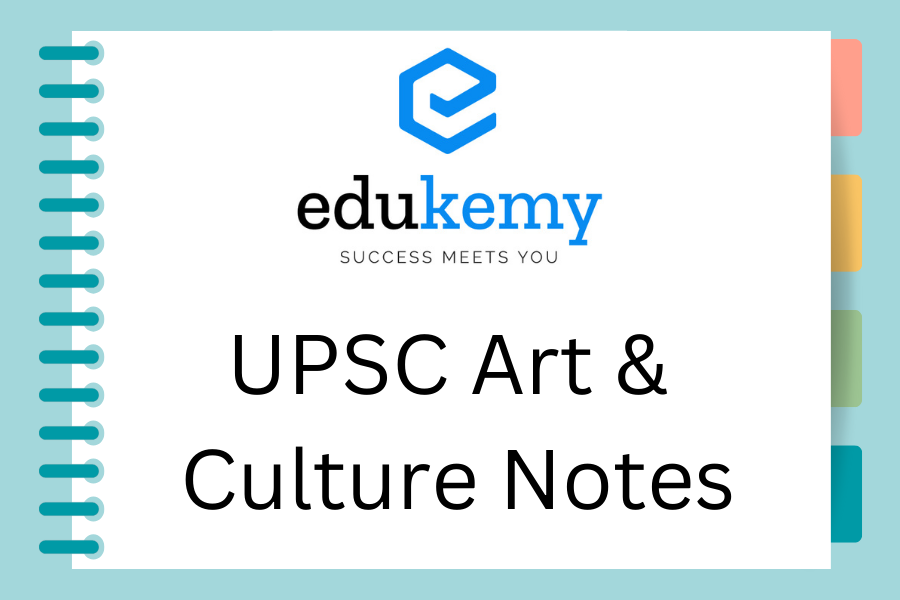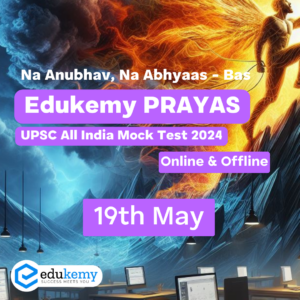The Art and Culture notes for UPSC play a pivotal role in guiding aspirants through a comprehensive preparation journey. Effectively addressing aspects such as Art, Culture, Literature, and Architecture poses a significant challenge for most candidates. Although the IAS exam doesn’t explicitly mention Art and Culture in its syllabus, questions related to these subjects are commonly featured in both UPSC prelims and mains. Therefore, it is imperative for students to thoroughly cover Indian Art and Culture, drawing insights from NCERTs and other reference sources.
This article aims to comprehensively cover all major topics essential for the exam. To facilitate ease of learning, we have categorized these topics into detailed sub-sections. Aspirants gearing up for the upcoming exam are encouraged to delve deep into these crucial areas to gain a profound understanding of the core concepts and fundamentals of the “Art and Culture” topic.
Art and Culture in the UPSC Syllabus
While the UPSC syllabus doesn’t explicitly mention the Art and Culture segment, questions about this area are regularly featured in both prelims and mains, aligning with the History syllabus. To effectively prepare Art and Culture notes for UPSC, it is crucial to cover the following key aspects:
- Examine the Significance of Three Art Forms: Explore the importance of three distinct art forms in shaping human personality.
- Objectives and Growth of Performing Arts: Delve into the objectives and aims of performing arts, tracing their evolution through various stages.
- Evolution of Drama in India: Chart the development and growth of drama across different phases in India, recognizing the significant contributions of folk theatre.
- Utilization of Performing Arts in Historical Periods: Investigate the use of performing arts during both medieval and ancient periods in India.
- Secular and Religious Art: Differentiate between secular and religious art in the Indian context.
- Appreciation of Classical Dances, Folk Music, and Folk Dances: Acknowledge and appreciate the contributions of classical dances, folk music, and folk dances to Indian culture. Additionally, explores the obstacles faced by performing arts in their cultural enrichment journey.
UPSC Art and Culture Study Guide
To commence the preparation of Art and Culture notes for UPSC, the NCERT Books stand as a fundamental resource. Following this, references to other materials such as Books, CCRT, and NIOS are beneficial. The NCERT books serve as a foundation, addressing core concepts and pivotal topics within the syllabus, ultimately aiding candidates in achieving exceptional performance in the exam. The critical topics to cover for the UPSC Exam include:
Language and Literature:
- Trends in Medieval Literature
- Modern Indian Literature
- Classical languages: Evolution & impact on society
- Tamil Language and Sangam Literature
- Vedic Literature
Paintings in India:
- Prehistoric Rock Paintings
- Medieval Period: Pala School of miniature paintings, Mughal miniature paintings, Development of Pahari, Rajput, and Deccan Paintings
- Modern Period: Bengal School of Art, Renaissance or Revivalist painting, Madras School of Art
- Decorative Art: Madhubani, Kalamkari, Kalighat, Warli, Pattachitra, themes of decorative paintings in India
Religious Philosophies:
- Buddhism and its Impact
- Jainism and its Impact
- Sufism and its Impact
- Vedanta Philosophy
- Bhakti Traditions
Music:
- Hindustani Music Evolution, features, and Impact
- Carnatic Music Evolution, features, and Impact
- Regional music and its impact
- Contribution of Some personalities: Amir Khusro, Mohammad Shah
- Modern Music
- Evolution of Indian Music
- Hindustani and Carnatic music differences and similarities
Dance:
- Well-known Classical dancers of India
- Classical Dances of India
- Themes in Indian folk dances
- Tracing Evolution of Dance (Rig Veda, Harappa, Nataraja)
Drama:
- Introduction (Natyashastra)
- Famous Modern Dramas and Dramatists.
- Various texts relating to the Drama period-wise (e.g., Mahabhasya, Mrichhakatika)
- Evolution of Drama in India
Bronze Sculptures in India:
- Harappan “Dancing Girl”
- Nataraja
- Pala School of Art (Bronze images, Manuscripts)
- Chola Bronzes
- Jain Tirthankaras Bronze Images
- Pallava Bronze Images
- Buddha bronze Images (e.g., Guptas and Vakatakas)
Visual Arts:
- Buddhist Sculpture
- Gupta Sculpture
- Nayaka Temples
- Temples of Kerala
- Temples of Assam
- Contemporary Paintings
- Temples of Khajuraho
- Temples of Himachal Pradesh
- Temples of Gujarat
- Gupta Period
- Sculptures of Harappan Civilization
- Post-Mauryan Period
- Temples of Gwalior
- Vijaynagar Period Temples
- Chola Period Temples
- Indo-Islamic Architecture
- Temples of Rajasthan
- Modern Architecture
- Post-Mauryan Period
- Cave Paintings
- Jain Sculptures
- Modern Indian Sculpture
- Temples of Odisha
- Paintings in the Deccan
- Coinage
- Miniature Painting in South India
- Temples of Bengal
- Temples of Jammu and Kashmir
- Regional Paintings
- Pallava Period Temples
- Medieval School of Sculpture
- Pandya Temples
- Pahari School of Painting
- Tradition of Mural Paintings in India
- Modern Paintings
- Temple Architecture
- Mauryan Architecture
- Tradition of Miniature Paintings in India
- Rashtrakuta Period Temples
- Harappan Period
- Pottery Tradition (Ochre: Colored Pottery (OCP), Black and Red Ware (BRW), Painted Grey Ware (PGW), Northern Black Polished Ware (NBPW), Glazed and Unglazed Pottery)
Architecture:
- Rajput School of Painting
- Post Mauryan Architecture
- Colonial Architecture
- Architectural Style of Harappan Civilization
- Medieval Period Architecture
- Impact of Persian and Greek Invasion on Indian Culture
- Monolithic Temples
- The emergence of Nalanda as a Centre of Learning
- Rock Cut temples
- Early Temples
- Influence of Buddhism and Jainism on Indian Architecture
- Spread of Indian Culture to Southeast Asia
- Free Standing Temples
- Indo Islamic Architecture
- Pallavas as great temple builders
- Gandhara and Mathura School of Art
- Conservation and Preservation of Architectural Structures
- Mauryan Architecture (322-182 BC)
- Nagara and Dravida Styles
- Cultural development during Gupta Age
Religion:
- Sufism
- Saints of Bhakti Movement
- Buddhism
- Islam
- Jainism
- Hinduism
- Sikhism
- Bhakti Movement
- Christianity
- Judaism
- Pre-Vedic Religion
- Zoroastrianism
Philosophy in India:
- Performing Arts
- Music in India
- Classical Indian Music: Main Pillars of Indian Music, Forms of Indian Music, Musical Instruments, Institutions Related to Music in India, Folk Music
- Dances of India: Concept of Dance in India, Concept of Ashta Nayika, Rasa and Bhava, Eight Classical Dance Forms in India, Folk Dances, Modern Dances
- Sports in India: Various Types of Sports, Genesis of Martial Arts, Forms of Traditional Martial Arts, Animal Sports
- Indian Theatre: History of Theatre in India, Traditional Theatre, Regional Theatre, Modern Theatre in India, Renaissance of Indian Theatre, Cinema in India
- Indian Puppetry: String Puppets, Shadow Puppets, Rod Puppets, Glove Puppets, Modern Puppetry, Tribal Puppetry
How to Make Art and Culture Notes for UPSC Preparation?
Effectively preparing Art and Culture notes is a pivotal aspect of the UPSC exam. To formulate a successful UPSC Preparation Strategy, candidates should delve into detailed information and understanding of crucial topics. Here’s a step-by-step guide:
Consult NCERT Books:
Lay a solid foundation by referring to NCERT books. These resources offer comprehensive coverage of core concepts and fundamentals, providing a thorough understanding of the subject matter.
Explore Recommended Books:
After mastering the essentials from NCERTs, turn to recommended books for the UPSC exam. These books, specifically tailored for Art and Culture, provide in-depth insights necessary for note-taking.
Practice UPSC Previous Year Questions:
Familiarize yourself with the exam pattern by practicing UPSC Previous Year Questions. This practice enhances your ability to anticipate question types and ensures effective exam preparation.
Utilize CCRT Resources:
The Centre for Cultural Resources and Training (CCRT) website is a valuable resource for note preparation. Explore the content available on this platform to supplement your understanding of Art and Culture topics.
By following these steps, aspirants can develop well-rounded and thorough Art and Culture notes, equipping themselves for success in the UPSC exam.
FAQs on UPSC Art and Culture Notes:
1. Is Art and Culture explicitly mentioned in the UPSC syllabus?
No, Art and Culture are not explicitly mentioned, but related questions are common in both prelims and mains.
2. What are the key aspects to cover in Art and Culture notes for UPSC?
Core aspects include three art forms’ significance, objectives of performing arts, evolution of drama, use in historical periods, secular and religious art, and contributions of classical dances and folk arts.
3. Why is it important to refer to NCERT books for Art and Culture preparation?
NCERT books provide a solid foundation, addressing core concepts and pivotal topics essential for a comprehensive understanding.
4. What should be done after covering NCERTs in Art and Culture preparation?
After NCERTs, refer to recommended books tailored for UPSC, providing in-depth insights for effective note-taking.
5. Why is practicing UPSC Previous Year Questions beneficial for Art and Culture preparation?
Practicing previous year questions helps familiarize candidates with the exam pattern, enhancing their ability to anticipate question types.
6. How can the CCRT website assist in Art and Culture note preparation?
The Centre for Cultural Resources and Training (CCRT) website offers valuable content to supplement understanding, serving as a helpful resource.
7. What are the major topics to cover in the UPSC Art and Culture Exam?
Major topics include language and literature, paintings in India, religious philosophies, music, dance, drama, bronze sculptures, visual arts, architecture, religion, and philosophy in India.
8. Why is it imperative for aspirants to delve deep into crucial areas in Art and Culture preparation?
Delving deep into crucial areas helps gain a profound understanding of core concepts and fundamentals essential for the UPSC exam.
How many main sections does the UPSC Art and Culture Study Guide cover?
The study guide covers three main sections: Language and Literature, Paintings in India, and Religious Philosophies.
10. What is the significance of Bronze Sculptures in India in Art and Culture preparation?
Bronze sculptures, including the Harappan “Dancing Girl” and Nataraja, hold cultural importance and are essential topics to cover in the preparation process.
In case you still have your doubts, contact us on 8792740517.
For UPSC Prelims Resources, Click here
For Daily Updates and Study Material:
Join our Telegram Channel – Edukemy for IAS
- 1. Learn through Videos – here
- 2. Be Exam Ready by Practicing Daily MCQs – here
- 3. Daily Newsletter – Get all your Current Affairs Covered – here
- 4. Mains Answer Writing Practice – here

